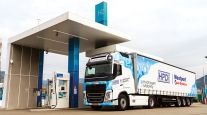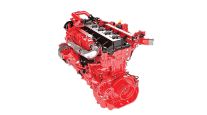Interest in Natural Gas Truck Fuel Increases; Industry Observers Predict Rising Sales
This story appears in the Aug. 29 print edition of Transport Topics.
Sales of natural-gas-powered trucks will grow faster than the rest of the North American market, hitting almost 30,000 units by 2017, consulting firm Frost & Sullivan said.
The new report said liquefied natural gas (LNG) and compressed natural gas (CNG) vehicles accounted for 0.9% of Classes 6-8 truck sales in North America last year, or 1,950 vehicles. Dedicated contract carriage and private fleets are the most likely applications for the vehicles.
Executives of two major leasing companies said they already have seen interest demonstrated in LNG and CNG engines, and original equipment manufacturers said demand for the vehicles is real, but they differed on how quickly the technology would be adopted.
“Fleets are even getting their money’s worth without a subsidy. We found you need a premium of $1.50 a gallon in the price of diesel, relative to the diesel-gallon equivalent in natural gas,” said Ryan Carmichael, the senior research analyst on the study by Frost & Sullivan’s Toronto office.
The researchers estimated the total truck market will grow from 226,400 vehicles last year to 371,700 in 2017, and by then 7.9% of sales — 29,500 North American trucks — will be powered by some form of natural gas.
Sandeep Kar, Carmichael’s fellow researcher at Frost & Sullivan, conceded that natural gas is not ideal for all applications of trucking, especially when fueling stations are not plentiful.
The researchers said that the area of California to Texas is most densely developed now and still growing.
They also said that dedicated carriage and store distribution are good introductory targets because they involve many regular miles through limited areas.
“We found a trucking company that ran a dedicated 140-mile route, one-way out and then back, between Dallas and Irving, Texas. Assuming $4 a gallon for diesel versus $2.40 for the diesel gallon-equivalent, the company had a six-month return on investment for that route,” Carmichael said.
The investment is substantial, though. The report said a basic Class 8 tractor using conventional diesel costs between $100,000 and $150,000, depending upon the specifications for the equipment and the number purchased. Using spark combustion technology adds $28,000 to $30,000 per truck, and compression technology adds about $72,500 to the invoice.
Fuel that is purely natural gas requires a spark for ignition, but some engines use natural gas mixed with a 3% to 5% diesel fuel that serves as a primer, enabling the fuel to be ignited by compression.
A Daimler Trucks North America executive said LNG/CNG vehicles are important, but he took issue with aspects of the Frost & Sullivan report.
“DTNA has enjoyed considerable success with natural gas sales in recent years, but a projection of nearly 8% total market penetration for natural gas vehicles in 2017 is overly optimistic, in our view,” said Robert Carrick, vocational sales manager for natural gas. “We see sales of CNG and LNG trucks continuing to rise industrywide, but there are a number of variables working against this kind of rapid growth.”
For example, Carrick said, “We do not see enough fuel infrastructure in place, under construction or planned to support this aggressive forecast, and what’s out there today is not optimal for medium and heavy trucks. The CNG flow rates average about 2 gallons per minute, and the NG industry needs 8 to 10 gallons per minute to fuel higher quantities of trucks. We are confident that the necessary infrastructure will take shape, but there are one-to-three-year lead times to get a station up and running.”
“Our natural gas customers are consistently realizing operational and performance benefits, but the industry needs stronger financial incentives to convince new customers to introduce natural gas vehicles in their fleets,” he said.
“We look forward to expanding market opportunities for NG products and feel that growth to 4% penetration in this time frame is very realistic, from today’s base of well below 0.5%,” Carrick said.
Ryder System provides dedicated contract carriage and full-service truck leasing, often to private fleets, and is involved already with about 300 natural gas vehicles, said Scott Perry, group director of vehicle supply management.
“We absolutely see that customers are very interested in natural gas vehicles,” he said, adding that fleets must carefully match costs against benefits.
“There’s a lot more to be considered on maintenance. Natural gas introduces some nuances on engine oils to be used, for instance,” Perry said. “There’s definitely some technological complexity to this that hasn’t been recognized.”
Perry and a leasing company executive said that many early adopters have switched to natural gas for reasons other than pure economics.
“Right now, natural gas is really strongest out west, or for a company like Coca-Cola that wants to be known for its green outlook,” said Dean Vicha, vice president of national accounts for the NationaLease truck system.
“It’s most popular among companies that are willing to be open-minded. Some are in markets such as organic foods, and they want to be seen as environmentally friendly,” Perry said.
However, there also is an economic basis to the interest. Perry said that, even at $3.50 to $4 a gallon for diesel, there is still a compelling case, and both he and Vicha said that, over the years if diesel moves to $5 a gallon, then there really is no argument about it at all.
Researchers Carmichael and Kar also said natural gas equipment should become more affordable as fueling infrastructure becomes available, the price of conventional diesel increases and manufacturers advance along the learning curve for less expensive production.
In one particular application, natural gas is a very obvious solution. Carmichael said refuse trucks that work at landfills have the best of all situations for fueling. Natural gas is a natural result of biological decay. In large landfills, it is abundant.
“We found a refuse hauler in Utah who paid 87 cents per diesel gallon-equivalent using landfill gas,” said Carmichael.
Kenworth Trucks hosted 100 customers in the Seattle area earlier this month for a natural gas presentation and ride-and-drive session, said Andy Douglas, the company’s national sales manager for specialty markets, including green technologies.
“This market really is growing; it’s doubling year-over-year — although from a very low starting point,” Douglas said.
There was interest from all regions of the United States and Canada, he said. He agreed with others about refuse, dedicated and private fleets as prime targets for natural gas, but he said that representatives of large for-hire truckload carriers also showed up for the session.
“They understand that this is a technology for the future for them. Fuel is their No. 1 cost, and they want to do whatever they can to hedge against that, especially when their customers are asking them to haul with natural gas,” Douglas said.
There is a gap in midsize engine offerings, he said, agreeing with a complaint by Ryder’s Perry that between 9 liters and 15 liters of engine displacement, there’s a large hole for natural gas models.
“Development in the mid-block range is very important, and I think that, in the near term, you’ll see some additional options available,” Perry said, but he declined to offer details.
“This is a very dynamic market now, and infrastructure is rapidly filling out,” Douglas said. “It’s important to understand, though, that this technology shares 80% to 90% of its components with conventional diesel. It’s a mature technology, and it’s proven under harsh environments.”
Peterbilt Motors Co. sees natural gas as an important part of its vehicle offering, said General Manager Bill Jackson.
“As the cost of diesel fuel rises, alternative fueling support infrastructure expands and emission regulations change, we see alternative-fuel vehicles continuing to increase nationwide in light-, medium- and heavy-duty applications,” Jackson said.




